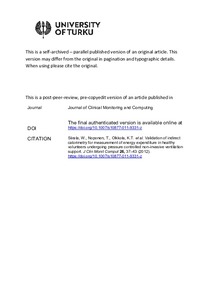Validation of indirect calorimetry for measurement of energy expenditure in healthy volunteers undergoing pressure controlled non-invasive ventilation support
Siirala W; Noponen T; Olkkola KT; Vuori A; Koivisto M; Hurme S; Aantaa R
Validation of indirect calorimetry for measurement of energy expenditure in healthy volunteers undergoing pressure controlled non-invasive ventilation support
Siirala W
Noponen T
Olkkola KT
Vuori A
Koivisto M
Hurme S
Aantaa R
SPRINGER HEIDELBERG
Julkaisun pysyvä osoite on:
https://urn.fi/URN:NBN:fi-fe2021042715228
https://urn.fi/URN:NBN:fi-fe2021042715228
Tiivistelmä
The aim of this validation study was to assess the reliability of gas exchange measurement with indirect calorimetry among subjects who undergo non-invasive ventilation (NIV). Oxygen consumption (VO2) and carbon dioxide production (VCO2) were measured in twelve healthy volunteers. Respiratory quotient (RQ) and resting energy expenditure (REE) were then calculated from the measured VO2 and VCO2 values. During the measurement period the subjects were breathing spontaneously and ventilated using NIV. Two different sampling air flow values 40 and 80 l/min were used. The gas leakage from the measurement setup was assessed with a separate capnograph. The mean weight of the subjects was 93 kg. Their mean body mass index was 29 (range 22-40) kg/m(2). There was no statistically significant difference in the measured values for VO2, VCO2, RQ and REE during NIV-supported breathing and spontaneous breathing. The change of sampling air flow had no statistically significant effect on any of the above parameters. We found that REE can be accurately measured with an indirect calorimeter also during NIV-supported breathing and the change of sampling air flow does not distort the gas exchange measurement. A higher sampling air flow in indirect calorimetry decreases the possibility for air leakages in the measurement system and increases the reliability of REE measurement.
Kokoelmat
- Rinnakkaistallenteet [27094]
